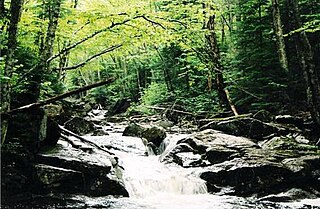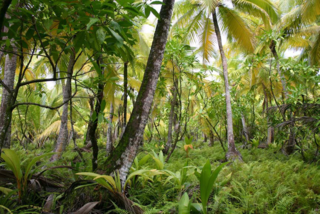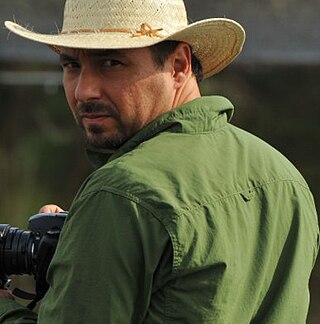
A herbivore is an animal anatomically and physiologically adapted to eating plant material, for example foliage or marine algae, for the main component of its diet. As a result of their plant diet, herbivorous animals typically have mouthparts adapted to rasping or grinding. Horses and other herbivores have wide flat teeth that are adapted to grinding grass, tree bark, and other tough plant material.

A frugivore is an animal that thrives mostly on raw fruits or succulent fruit-like produce of plants such as roots, shoots, nuts and seeds. Approximately 20% of mammalian herbivores eat fruit. Frugivores are highly dependent on the abundance and nutritional composition of fruits. Frugivores can benefit or hinder fruit-producing plants by either dispersing or destroying their seeds through digestion. When both the fruit-producing plant and the frugivore benefit by fruit-eating behavior the interaction is a form of mutualism.

Ecosystem ecology is the integrated study of living (biotic) and non-living (abiotic) components of ecosystems and their interactions within an ecosystem framework. This science examines how ecosystems work and relates this to their components such as chemicals, bedrock, soil, plants, and animals.

Ecological restoration is the process of assisting the recovery of an ecosystem that has been degraded, damaged, or destroyed. It is distinct from conservation and preservation in that it is an "attempt to co-design nature with nonhuman collaborators." Ecological restoration can reverse biodiversity loss, combat climate change, and support local economies. The United Nations named 2021-2030 the Decade on Ecosystem Restoration.
Trophic cascades are powerful indirect interactions that can control entire ecosystems, occurring when a trophic level in a food web is suppressed. For example, a top-down cascade will occur if predators are effective enough in predation to reduce the abundance, or alter the behavior of their prey, thereby releasing the next lower trophic level from predation.
An ecological cascade effect is a series of secondary extinctions that are triggered by the primary extinction of a key species in an ecosystem. Secondary extinctions are likely to occur when the threatened species are: dependent on a few specific food sources, mutualistic, or forced to coexist with an invasive species that is introduced to the ecosystem. Species introductions to a foreign ecosystem can often devastate entire communities, and even entire ecosystems. These exotic species monopolize the ecosystem's resources, and since they have no natural predators to decrease their growth, they are able to increase indefinitely. Olsen et al. showed that exotic species have caused lake and estuary ecosystems to go through cascade effects due to loss of algae, crayfish, mollusks, fish, amphibians, and birds. However, the principal cause of cascade effects is the loss of top predators as the key species. As a result of this loss, a dramatic increase of prey species occurs. The prey is then able to overexploit its own food resources, until the population numbers decrease in abundance, which can lead to extinction. When the prey's food resources disappear, they starve and may go extinct as well. If the prey species is herbivorous, then their initial release and exploitation of the plants may result in a loss of plant biodiversity in the area. If other organisms in the ecosystem also depend upon these plants as food resources, then these species may go extinct as well. An example of the cascade effect caused by the loss of a top predator is apparent in tropical forests. When hunters cause local extinctions of top predators, the predators' prey's population numbers increase, causing an overexploitation of a food resource and a cascade effect of species loss. Recent studies have been performed on approaches to mitigate extinction cascades in food-web networks.
Ecological extinction is "the reduction of a species to such low abundance that, although it is still present in the community, it no longer interacts significantly with other species".
Tropical ecology is the study of the relationships between the biotic and abiotic components of the tropics, or the area of the Earth that lies between the Tropic of Cancer and the Tropic of Capricorn. The tropical climate experiences hot, humid weather and rainfall year-round. While many might associate the region solely with the rainforests, the tropics are home to a wide variety of ecosystems that boast a great wealth of biodiversity, from exotic animal species to seldom-found flora. Tropical ecology began with the work of early English naturalists and eventually saw the establishment of research stations throughout the tropics devoted to exploring and documenting these exotic landscapes. The burgeoning ecological study of the tropics has led to increased conservation education and programs devoted to the climate.
Plants and herbivores have co-evolved together for 350 million years. Plants have evolved many defense mechanisms against insect herbivory. Such defenses can be broadly classified into two categories: (1) permanent, constitutive defenses, and (2) temporary, inducible defenses. Both types are achieved through similar means but differ in that constitutive defenses are present before an herbivore attacks, while induced defenses are activated only when attacks occur. In addition to constitutive defenses, initiation of specific defense responses to herbivory is an important strategy for plant persistence and survival.

Defaunation is the global, local, or functional extinction of animal populations or species from ecological communities. The growth of the human population, combined with advances in harvesting technologies, has led to more intense and efficient exploitation of the environment. This has resulted in the depletion of large vertebrates from ecological communities, creating what has been termed "empty forest". Defaunation differs from extinction; it includes both the disappearance of species and declines in abundance. Defaunation effects were first implied at the Symposium of Plant-Animal Interactions at the University of Campinas, Brazil in 1988 in the context of Neotropical forests. Since then, the term has gained broader usage in conservation biology as a global phenomenon.

Plant ecology is a subdiscipline of ecology that studies the distribution and abundance of plants, the effects of environmental factors upon the abundance of plants, and the interactions among plants and between plants and other organisms. Examples of these are the distribution of temperate deciduous forests in North America, the effects of drought or flooding upon plant survival, and competition among desert plants for water, or effects of herds of grazing animals upon the composition of grasslands.

Community genetics is a recently emerged field in biology that fuses elements of community ecology, evolutionary biology, and molecular and quantitative genetics. Antonovics first articulated the vision for such a field, and Whitham et al. formalized its definition as "The study of the genetic interactions that occur between species and their abiotic environment in complex communities." The field aims to bridge the gaps in the study of evolution and ecology, within the multivariate community context in which ecological and evolutionary features are embedded. The documentary movie A Thousand Invisible Cords provides an introduction to the field and its implications.
Empty forest is a term coined by Kent H. Redford's article "The Empty Forest" (1992), which was published in BioScience. An "empty forest" refers to an ecosystem that is void of large mammals. Empty forests are characterized by an otherwise excellent habitat, and often have large, fully grown trees, although they lack large mammals as a result of human impact. Empty forests show that human impact can destroy an ecosystem from within as well as from without.

Salt marsh die-off is a term that has been used in the US and UK to describe the death of salt marsh cordgrass leading to subsequent degradation of habitat, specifically in the low marsh zones of salt marshes on the coasts of the Western Atlantic. Cordgrass normally anchors sediment in salt marshes; its loss leads to decreased substrate hardness, increased erosion, and collapse of creek banks into the water, ultimately resulting in decreased marsh health and productivity.

Mauro Galetti. is a Brazilian ecologist and conservation biologist. He is a full professor in the Department of Biodiversity at the Universidade Estadual Paulista, Rio Claro, São Paulo and has worked at Stanford University (USA), Aarhus University (Denmark) and the University of Miami (USA). He also holds a position as a Courtesy Associated Professor at Florida International University, Miami, FL. Galetti's work has centered on the analysis of the ecological and evolutionary consequences of defaunation. He was awarded by WWF in 1998 and was a Tinker Fellow at Stanford University and a visiting professor at Aarhus Universitet, Denmark in 2017.
Phyllis Dewing Coley is a Biology professor currently teaching at the University of Utah. In 1996 she received the University's Distinguished Research Award. She has been a research associate at the Smithsonian Tropical Research Institute since 1995. In 2023, she was elected to the National Academy of Sciences.
José Sarukhán Kermez is a plant biologist and ecologist. He is currently the National Coordinator for Mexico’s National Commission for Knowledge and Use of Biodiversity (CONABIO). He received a B.A. from National Autonomous University of Mexico (UNAM) in 1964, a Masters from Postgraduate College (Chapingo), and a Ph.D. (Ecology) from the University of Wales. A known expert in the biodiversity of Mexico, Sarukhán’s main interests include tropical ecology, plant population ecology, and the systems ecology of both temperate and tropical ecosystems, as well as training and education. He has published over 110 research papers and authored and co-authored several books.
Elizabeth T. Borer is an American ecologist and a professor of ecology, Evolution and Behavior in the College of Biological Sciences at the University of Minnesota.
Ernesto A. Medina is a plant ecologist specializing in plant physiology when adapting to the changing environment. He is an elected international member of the National Academy of Sciences, and is adjunct professor in the department of Center for Applied Tropical Ecology and Conservation (CREST-CATEC).

Megaherbivores are large herbivores that can exceed 1,000 kg (2,200 lb) in weight. They first appeared 300 million years ago in the early Permian, in the form of synapsids. They were then replaced by megaherbivorous dinosaurs that went extinct in the Cretaceous-Paleogene extinction event. After this period, small mammalian species evolved into large herbivores in the Paleogene. During the Quaternary Extinction Event, megaherbivores disappeared on most continents on Earth. Recent megaherbivores include elephants, rhinos, hippos, and giraffes. There are nine extant species of terrestrial megaherbivores living in Africa and Asia. The African bush elephant is the largest extant species.









